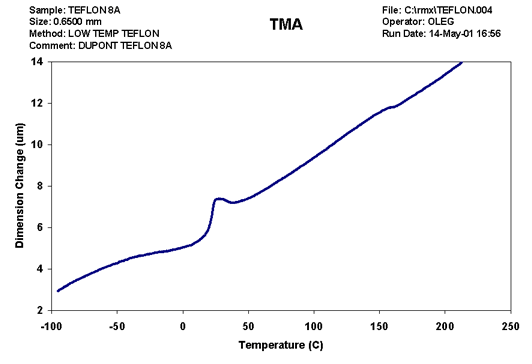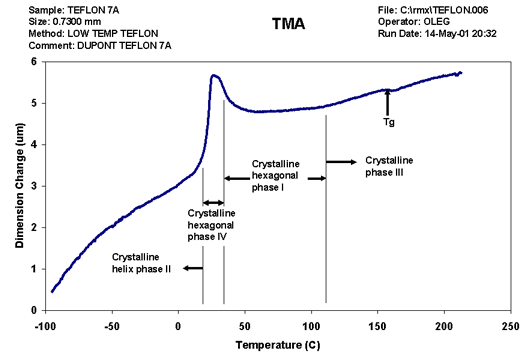CTE, Thermal Expansion Measurements
CTE, or the coefficient of thermal expansion, is measured using our ThermoMechanical Analyzer, or TMA. The thermal expansion of materials is not actually linear, but the quadratic expansion term is often small, so the thermal expansion is often close to linear over an extended temperature range.
The thermal expansion is only nearly linear if the material does not exhibit a phase transition in the temperature range of interest. There are many materials for which such phase changes do occur. For instance, in a polymeric material there is such a thermal expansion rate-changing phase transition when the polymer passes through a crystalline or a glass transition. In some plastic materials specimens, different parts of the specimen may have different transition temperatures, such as we have found dramatically illustrated in the plastic encapsulation of an IC package due to the effects of a heat sink on the processing of the plastic encapsulation material. Glassy materials also have a glass transition temperature. Of course phase changes may also occur in metal and inorganic chemical samples also.
Some of the properties of our ThermoMechanical Analyzer are:
- The TMA dilatometer uses interchangeable probes at varied loads to make a number of measurements, including the softening temperature or glass transition temperature, tensile modulus, compression modulus, coefficient of thermal expansion (CTE), melting temperature, crystalline phase transition temperature, crystalline to amorphous transition temperatures, and creep under load, by measuring the change of a dimension of a material. Note that the thermal expansion of a material may not be linear.
- Samples in the form of plugs, films, powders, or fibers, are compressed or held in tension by a probe assembly. Movement of the probe is measured electrically by a linear variable differential transformer (LVDT) attached to the probe.
- Capable of testing polymers and plastics, metals, glasses, ceramics, inorganics, composite materials, IC packages, semiconductors, small devices, adhesives, sealants, potting compounds, PCBs, and coatings.
- Temperatures can range from -150°C to 800°C.
- Sample dimensions: a maximum of 25 mm in height and 9.5 mm in diameter; a minimum of 0.1 μm thick and 1.5 mm in diameter, an ideal thickness for sheet materials is 1-4mm. Taller samples should have small lateral dimensions, so the sample interior temperature will not differ substantially from the surface temperature. This is less a concern the more thermally conductive a sample is.
- The applied load can range from 0-100 g. The softening with temperature under various pressures can be examined in this way.
- The change of dimension should be greater than 2×10-3 μm/°C for a successful measurement.
ASTM Test Methods
- ASTM E228 – Standard Test Method for Linear Thermal Expansion of Solid Materials with a Vitreous Silica Dilatometer
- ASTM E831 – Standard Test Method for Linear Thermal Expansion of Solid Materials by TMA
- ASTM E1545 – Standard Test Method for Assignment of the Glass Transition Temperature by TMA
Please contact us with inquiries specifically about TMA analyses.
Illustrative Example: Rapid Thermal Expansion of PTFE Crystalline Phase
TMA dilatometry was used to characterize the properties of various PTFE powder materials. These were examined after pressing them into sheets. The sheet thickness was measured from -100°C to 200°C using a ramp rate of 4°C/min. The first of several TEFLON® materials (Figure 1) exhibits an extensive crystalline transition at approximately 19°C due to a transformation of the Phase II helix crystal structure first to the Phase IV hexagonal crystal structure and then to the Phase I hexagonal crystal structure. This large peak created at transition indicates a PTFE which has a substantial crystalline phase and exhibits a drastic dimension change as it changes the crystalline phase. Also shown by the TMA is the softening point (Tg or Ts) of the TEFLON® at approximately 160°C. Data for another of several samples is seen in Figure 2. This TEFLON® material exhibits a significantly smaller crystalline to amorphous transition dimension increase compared to the material observed in Figure 1. This material initially consisted of a greater concentration of amorphous material. For our customer’s intended use, a rapid thermal expansion of a PTFE material at the crystalline transition temperature could not be tolerated. Their requirement was therefore for an amorphous PTFE material. Note that the first PTFE material has almost no temperature range with a linear thermal expansion characteristic.

Inquiries about CTE or thermal expansion measurements can be addressed to Dr. Vaidheeshwar Ramasubramanian at Vaidheeshwar.R@andersonmaterials.com or you can find other contact information on our “Contact Us” page.


